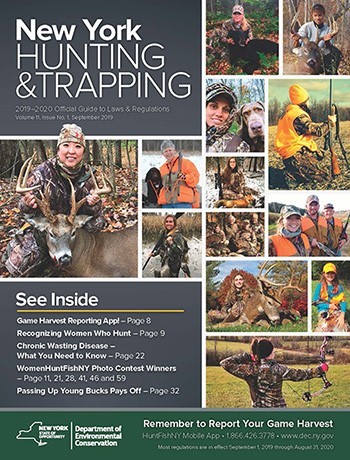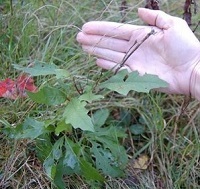Hunting and Trapping Newsletter
The New York State Department of Environmental Conservation sent this bulletin on 08/27/2019 12:01 PM EDT |
| DEC Delivers - Information to keep you connected and informed from the NYS Department of Environmental Conservation |
| Share or view as a web page || Update preferences or unsubscribe |
Hunting and Trapping Newsletter |
Take Our Survey On The New Hunting and Trapping Regulations Guide
Each year, DEC produces the New York Hunting and Trapping Regulations Guide, a summary of the laws and regulations associated with hunting and trapping. For the past several years, the guide has included additional content like articles about game management issues and photos submitted by hunters and trappers. The guide also includes advertisements, which offset a portion of the production costs. Hunters can pick up hard copies of the guide where licenses are sold, or get an electronic version on DEC's website and mobile apps. We’d like to hear how we can improve the guide for your use and enjoyment. Complete a short survey about your experience using the guide and the types of content you’d like to see. We’ll use the feedback we receive to make changes to future issues.
Monitor Ecological Impacts of Deer in Your Home Forest
DEC has partnered with Cornell University to provide a way for forest owners and people concerned about forest health to assess and monitor the ecological impacts of deer. It involves marking some plants and measuring their height at the same time each year. Spring is the best time to monitor wildflowers, but you can monitor seedlings in the fall. The method is called AVID, which stands for Assessing Vegetation Impacts from Deer, and the AVID website provides all the information you need to start monitoring. For people who would like some hands-on training in using AVID, Cornell Cooperative Extension offers occasional half-day workshops that will be listed on their website when they’re scheduled.
Remember to Report Your Turkey Sightings
Each year, we ask people to report the wild turkeys they see during the month of August. Why August? It’s the perfect part of summer when we see birds in fields, often accompanied by poults (young of the year), feeding on abundant insects and other food sources. They are out in the open, and it’s easy to distinguish between big birds (adults) and little birds (poults). It’s hard out there for poults during the early part of the summer (June and July). Between weather, predators, and other risk factors, many will not make it to the fall. Young birds observed in August have a better chance of surviving through the season, especially birds in groups because they provide a better assessment of whether or not it was a good year for reproductive success (the number of nests that hatched and the number of poults that survived). Poults grow quickly, so if we delay the survey until September, it would be difficult to distinguish between adults and young birds. August is the sweet spot for reporting your sightings. Thanks for your help! |


 If you like to spend time in the woods in the fall and are interested in keeping those woods healthy, consider monitoring tree seedling growth to find out whether deer browsing is threatening the ability of the forest to sustain itself. Deer populations in parts of the state are high enough to harm their habitat and the forest ecosystem. High deer densities can eliminate understory plants, and the future of the forest can be at risk if deer eat tree seedlings before they can grow up to replace trees that fall. Heavy shrub browsing and ground cover also destroy habitat for birds and other wildlife.
If you like to spend time in the woods in the fall and are interested in keeping those woods healthy, consider monitoring tree seedling growth to find out whether deer browsing is threatening the ability of the forest to sustain itself. Deer populations in parts of the state are high enough to harm their habitat and the forest ecosystem. High deer densities can eliminate understory plants, and the future of the forest can be at risk if deer eat tree seedlings before they can grow up to replace trees that fall. Heavy shrub browsing and ground cover also destroy habitat for birds and other wildlife.
 With August drawing to a close, remember to
With August drawing to a close, remember to